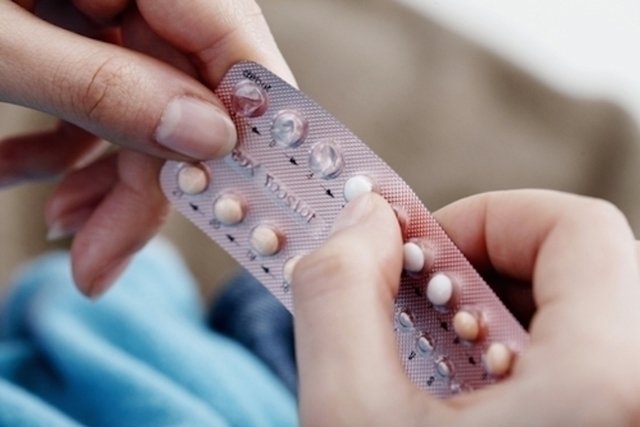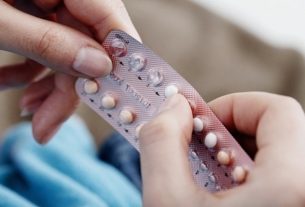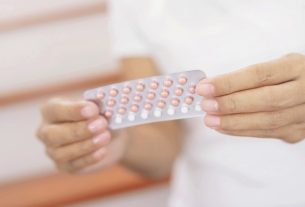When you decide to stop using contraceptives, some changes may occur in your body, such as weight loss or gain, delayed menstruation, worsening of cramps and PMS symptoms. Furthermore, after stopping contraceptives, the risk of pregnancy may return as soon as the ovaries return to their normal function.
The effects of stopping contraceptives begin to be felt about 2 weeks after stopping the medication, when the body notices the lack of artificial hormones and begins to have to produce them naturally, but this can vary according to each woman and the type of contraceptive used.
The contraceptive can be stopped at any time, but preferably when the pack is finished, to have better control of the cycle. See how to use contraceptives.

Symptoms after stopping taking contraceptives
Some symptoms that may appear after stopping taking contraceptives are:
1. Weight change
The substances present in contraceptives can cause fluid retention, with varying intensity according to each type, leading to weight gain. Therefore, when you stop taking the contraceptive, it is possible to eliminate excess fluid, leading to weight loss.
On the other hand, as stopping contraceptives can cause greater fluctuations in a woman’s mood, weight gain also occurs due to a greater appetite, unwillingness to do physical activity and a greater desire for sweets.
What to do: The ideal is to focus on a healthy diet, rich in calcium, vitamin B6 and magnesium, such as vegetables, fruits, greens, fish and whole grains, which help the body balance hormone levels and eliminate toxins. These toxins worsen fluid retention and bad mood. Performing physical activity is essential for improving circulation, burning fat and regulating your appetite.
2. Menstruation dysregulation
When stopping contraceptive use, the ovaries need to produce their hormones again, which takes time and the production of hormones does not occur regularly, so changes in menstrual cycles can be noticed.
What to do: these changes lasting a few days are usually normal, but if they are very intense, to the point of going 2 months without menstruating, or menstruating 3 times a month, you should consult a gynecologist for assessments of hormone levels and functioning of the ovaries. A tip is to always write down the dates of your periods and how long they lasted, to know how the rhythm of your cycle works.
3. Worsening menstrual cramps
In the absence of the effect of contraceptives, the tissue of the uterus becomes thicker, which is a preparation for a possible pregnancy, causing worsening of cramps and blood flow during menstruation.
What to do: to relieve menstrual cramps, you can take anti-inflammatories, such as ibuprofen or mefenamic acid, in addition to applying a warm water compress to the belly or lower back, these can relieve cramps. Check out some tips to reduce menstrual cramps.
4. PMS and mood swings
As the female hormones, progesterone and estrogen, produced naturally in the ovaries, have a more intense and abrupt variation throughout the month, compared to when taking contraceptives, it is more common for PMS to worsen, with irritability, sadness, impulsivity, changes sleep and headache.
What to do: to alleviate PMS symptoms, you should focus on calming foods, such as passion fruit juice, chamomile tea, 1 piece of dark chocolate, as well as relaxation, meditation and stretching exercises. Check out more tips on how to combat the main symptoms of PMS.
5. Skin changes
Most pills reduce testosterone production, leaving the skin cleaner, drier and without clogged pores. Therefore, when contraceptive use is suspended, it is very common for the skin to have more oil and pimples. Some types of contraceptives, however, may have different compositions, so the effect may be opposite.
What to do: to combat oily skin, you can use some astringent lotions or soaps, purchased at the pharmacy, and use 1 or 2 times a day. But, when the formation of pimples is more intense, it is necessary to go to the dermatologist for guidance on the use of more specific creams, such as benzoyl peroxide or adapalene.
6. Increased hair and libido
As many contraceptives limit the production of hormones, including testosterone, it is common that when you stop taking contraceptives, these hormones are produced naturally, which can result in the appearance of unwanted hair, a slightly deeper voice, in addition to increased desire for sexual contact.
What to do: Testosterone is present naturally in women, however, if symptoms of excess testosterone are noticed, such as an excessive increase in the amount of hair, it is important that the gynecologist is consulted so that female hormones can be assessed and thus evaluated. the need for female hormone supplementation. See how to reduce testosterone in women.
7. Greater amount of intimate secretions
It is common that after stopping contraceptive use, there is a greater production of intimate secretions, both in everyday life and in intimate contact, resulting from the increase in natural estrogen production.
What to do: This type of secretion is perfectly natural, and indicates that the ovaries are working well. It is important to change your underwear every time you shower, to maintain hygiene and prevent the proliferation of microorganisms in the area.
How long does it take to get pregnant
The time for a woman’s body to adapt to the absence of contraceptive hormones can vary, generally from a few days to 1 year, especially if the contraceptive has been used for many years and depending on the type of contraceptive used.
Injectable contraceptives, as they contain higher levels of hormones, can cause a longer delay for the ovaries and uterus to allow a pregnancy, however, everything will depend on each organism’s ability to eliminate artificial substances from the body and produce its own again.
There are foods that can help the body produce its own hormones and nutrients, and eliminate the artificial effects of contraceptives, especially those rich in zinc, vitamins B6, A, C, E and omega-3, such as eggs, fish, broccoli, oats , quinoa, wheat, sunflower seeds and avocado. Find out more about how to increase fertility with food.

Sign up for our newsletter and stay up to date with exclusive news
that can transform your routine!
Warning: Undefined array key "title" in /home/storelat/public_html/wp-content/plugins/link-whisper-premium/templates/frontend/related-posts.php on line 12
Warning: Undefined array key "title_tag" in /home/storelat/public_html/wp-content/plugins/link-whisper-premium/templates/frontend/related-posts.php on line 13



